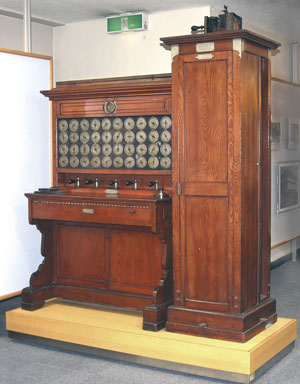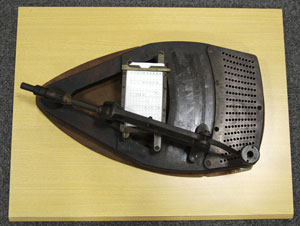

- Home >
- Artifacts of IP Heritage >
- 2008 >
- Kawaguchi Style Electric Tabulation Machine and Turtle-shape Perforator
Kawaguchi Style Electric Tabulation Machine and Turtle-shape Perforator


| Manufactured in | 1905 |
|---|---|
| Manufactured by | Denshin-Todai-Yohin Seizosho (a shop manufacturing components of telegraph lighthouses) , the Ministry of Posts and Telecommunication |
| Owner | Statistics Bureau |
| Location of historical materials | Statistical Museum 19-1 Wakamatsu-cho, Shinjuku-ku, Tokyo 162-8668 Japan (In the premises of the Statistics Bureau of Japan) |
| Visitor information | Open to the public |
| Contact | Statistical Museum https://www.stat.go.jp/library/english/index.htm |
In 1902 "the Law of Census" was announced by Japanese government, who considered a tabulating machine would be necessary to compile the census effectively and decided to develop a domestic machine. As the Ministry of Posts and Telecommunication was asked to investigate this matter, Kawaguchi Ichitaro, engineer of Denshin-Todai-Yohin Seizosho (a shop to manufacture components of telegraph lighthouses) of the Ministry, began to research and develop a tabulating machine and completed a prototype in 1905.
Kawaguchi's machine consists of two parts, a sorting unit (left side of the photo) and a counting unit (right side of the photo), and sorts and tabulates input data by connecting these two units. Data cards perforated by Kamenoko-gata Senkoki (a turtle-shape perforator) are inserted from a card reader at the top of the sorting unit. By operating handles, sorting hands (a sending hand and a receiving hand) are in contact through a punched hole on the card and electric current flows, and a long hand (the unit's pointer) of a clock-like counter of the counting unit moves one step (one card). The hands consists of a long one and a short one, and a long hand shows 100 cards per step and a short one does 10,000 cards per step, and both hands return to zero after one rotation. The number of perforated cards for each item is shown in counters.
This tabulation machine prototype is preserved at Statistical Museum and is exhibited as well as other machines.
